Restoration in the Heart of Philadelphia
Joel Davis
Photos Courtesy The Marble Restoration Company
The Marble Restoration Company of Lafayette Hill, Pennsylvania, is a new company with a rising reputation for restoring and maintaining old stone.
Since its founding in 2014, The Marble Restoration Co. has developed expertise in not only restoring stone in historical buildings but maintaining its character.
“Typically, we restore marble and make it look new again,” President Rick Sirianni said. “That’s the easy part of the work. In this case, we restore the marble but make it look old again. That takes a little bit of talent to maintain the old look.”
 |
|
The Marble Restoration Co. has mastered the challenging art of cleaning and restoring delicate antique stone work like this turn-of-the 20th century mosaic floor in the Belgravia Hotel building. |
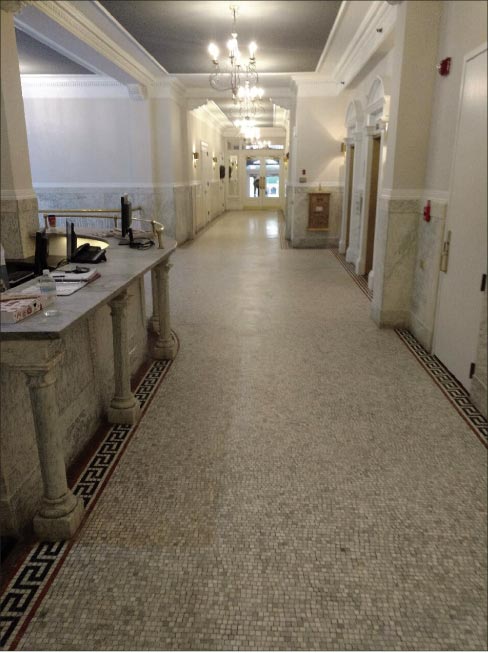 |
Offering full stone restoration and maintenance services, the company does not install or sell stone. Half of its jobs are commercial. The rest are residential.
Recently, the company worked on an award-winning restoration project in Philadelphia. It participated in the restoration of the Belgravia Hotel, also known as Peale House. Famous former residents of the building include violist William Primrose and violinist Efrem Zimbalist (once considered the finest violinist in the world). It was built in the Beaux Arts style in 1902 and made it to the National Register of Historic Places in 1982. It has since been converted to condominiums.
Jennifer Smith of Jennifer Smith Designs, based in Doylestown, Pennsylvania, oversaw interior design for the project on behalf of the Belgravia Condominium Association.
Smith decided to bring in a company to restore the stone after the project was underway. “Once the painting started going on, we were like, ‘If we’re going to do it, let’s do it right,’” she said.
Smith found The Marble Restoration Co. through reviews of the business. “The second I called it was a pleasant experience from beginning to end,” she said. “They feel very family-oriented. It was wonderful.”
The fact The Marble Restoration Co. took the time to provide a free demonstration of its capabilities helped it gain the contract. “They did a sample of a generous size that was included and that really helped the process,” Smith said.
This was not the first historical restoration project for the company, Sirianni said. “One of the reasons the client was attracted to us was because of all the historical restoration we have done: the Cathedral Basilica of Saints Peter and Paul in preparation of the Pope’s visit; a restoration of a historical home designed by (famed architect) Louis Kahn; the restoration of the historical Curtis Center in Philadelphia. In each case the goal was to enhance the historical nature of the stone.”
When it came to the Belgravia Hotel project, The Marble Restoration Co. faced three major challenges.
“The square footage of the job was about 3,000 square feet for floor, steps, and walls,” Sirianni said. “They had walls that were old Carrara Venato marble – that white marble with light gray veining in it. It went up probably five feet on the walls from floor up. They were dirty, they were stained, there was some rusting on it. They had a front desk of that marble and posts that all had to be cleaned.”
This meant hours of careful work by hand. “We used honing pads because they didn’t want a shine on it,” Sirianni said. “We had a lot of grout replacement to do on those walls. There were a lot of grout voids and a lot of dirty grout. It took a large amount of time. After we got it cleaned and honed down, we used impregnating sealer on it.”
The next challenge was the mosaic tile floor. “The center of the floor had this beautiful design laid into it,” Sirianni said. “It was wobbly and wavy and had a lot of cracks and a lot of missing tiles.”
This involved slow and careful work. The technicians also had to pay attention to the characteristics of the floor.
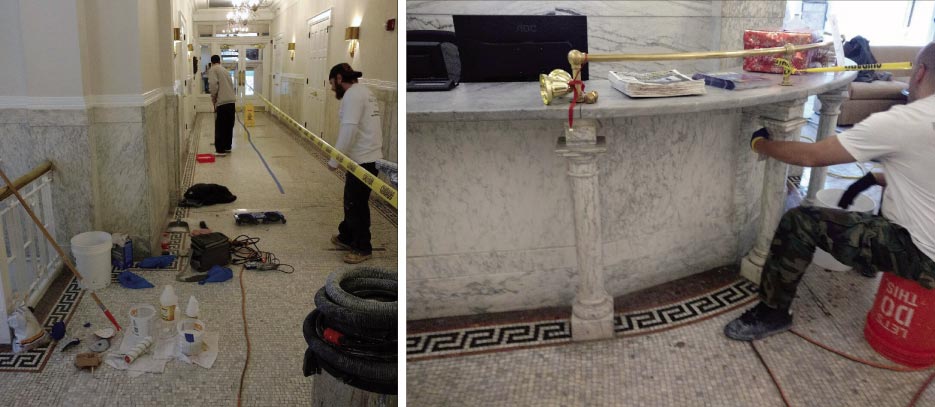 |
|
Cleaning and restoration in progress on the Carrara marble walls, reception desk, and the extremely dirty and worn tile flooring. The job covered about 3,000 square feet of marble. |
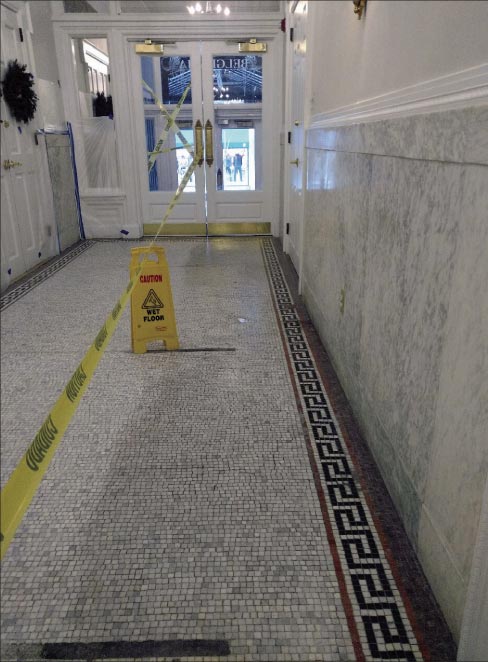 |
|
Working in an occupied building presents a unique set of challenges – especially in the winter, in Philadelphia. The Marble Restoration Co. dedicated six technicians to the project for about two weeks. |
“We used mostly diamond impregnated pads on it to restore that floor,” Sirianni said. “We finished it with honing pads after the repairs were done and put an impregnating sealer on it.”
The technicians did not try for a full-scale repair of the floor. “We knew we’d never get tiles to match it,” Sirianni said. “The floor was so old. We took out those old repairs, and we color-matched the repairs to the existing tiles and smoothed that out.”
The standard used for crack repair on the project was to fix anything big enough to catch the heel on a woman’s shoe. Otherwise, the crew left the cracks alone at the behest of the owner, Sirianni said. “There was all this thin spiderweb cracking on the floor. They didn’t want us touching that. They liked those spider cracks, as part of the history.”
The Marble Restoration Co. dedicated six technicians to the project for about two weeks. The floor was the biggest challenge, Sirianni said.
“When you first went in there and looked at it, it was a mess,” he said. “It was filthy, it had wax buildup in corners, and it had really ugly old repairs. The difference between before and after was just amazing. That’s the thing we’re most proud of. Our guys take a lot of pride in that type of stuff.”
The steps were also challenging. “They were in horrible shape,” he said. “We had to restore all of those Carrara steps. They were really badly scratched, badly worn out, and were terribly stained. The steps, which were 95 square feet, nearly took as long and as much manpower as the tile floor. A lot of that was done by hand.”
In addition to the technical challenges, the company had to deal with the logistics of working in an occupied building. Crews were only able to work 9 a.m. to 5 p.m. each day and had to work around the traffic generated by the homeowners living in the 54-unit condominium complex.
“It was a lot of work,” Smith said. “It’s a working condo association so, especially with the winter and the salt and everything, they had a lot to deal with. They did a great job.”
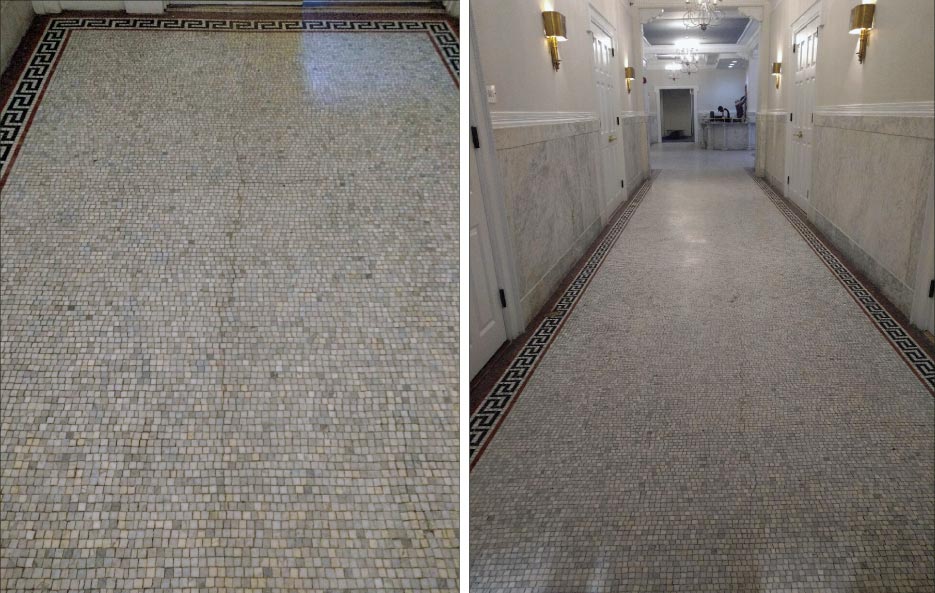 |
|
Hallway floor and wall after restoration. Restoring stone in historical buildings is not just a matter of technique, it’s a matter of communication. Sirianni said, “When you’re looking at this mosaic floor at the Belgravia, it’s got a lot of cracks all over it and a lot of old bad repairs, but they say, ‘Listen, we like the fact the cracked floor gives it that old antique look.’ It required some work to decide what to fix and what not to fix.” |
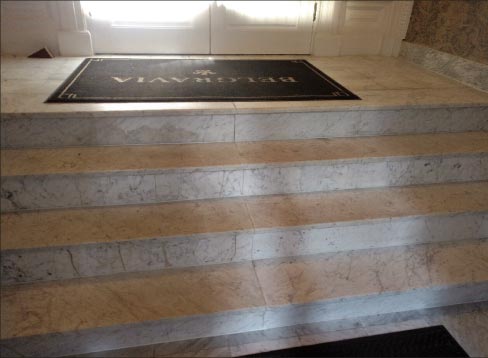 |
|
Above: Crack repairs to ensure safety were equally important when restoring the marble stair landing, treads and risers. |
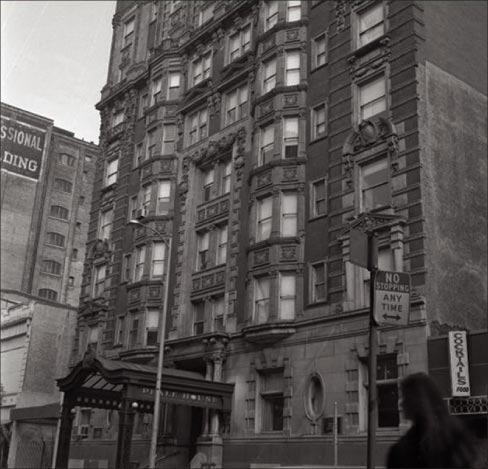 |
|
The Belgravia building (also known as the Peale House) was built in 1902, and is on the National Register of Historic Places. © City of Philadelphia, dept. of records |
The Marble Restoration Co. was able to deal with any surprises that popped up during the process, Smith said. “You don’t know (conditions) until you get in there and start pulling things apart. They were cool and calm.”
Over the years, The Marble Restoration Co. has learned that restoring stone in historical buildings is not just a matter of technique. It’s also about communication.
“There are two things we’ve learned that have become part of our routine,” Sirianni said. “One is to truly interview the owner or manager, whoever is hiring us, to get a clear understanding of what their expectations are, because when you are restoring a piece of marble to look new again, it’s easy. On these older buildings, though, what is the end result you’re looking for?”
The Belgravia Hotel project illustrates the case in point. “But when you’re looking at this mosaic floor at the Belgravia, it’s got a lot of cracks all over it and a lot of old bad repairs, but they say, ‘Listen, we like the fact the cracked floor gives it that old antique look,’” he said. “It required some work to decide what to fix and what not to fix.”
At the Esherick House, designed by Louis Kahn, the owners had a similar request. “The owners were intent on restoring it to its original state,” Sirianni said. “A lot of the marble and the slate, areas around the hearth and the fireplace, had holes in it. Our instinct was to patch up the holes. The owners said “No, no, no, we don’t want you doing that. We want you just cleaning them out and leaving the holes in there.’”
The work on the Esherick House earned The Marble Restoration Co. a 2016 Grand Jury Award from the Preservation Alliance of Greater Philadelphia (see Slippery Rock online archive, August 2016).
The second lesson involves a little more hands-on work, Sirianni said. “We’ve learned that no matter how well we understand (stone restoration), we go in and do a test first, so we can say ‘Here’s what it is going to look like when we’re done–are you happy with that?’ That has saved us a lot of aggravation by getting everybody on the same page.”
It might cost a little more to send out a technician to test for free, but it pays off in the end. “In the long run, it becomes part of the contract with the customer, saying ‘This is what it’s going to look like, sign off on that,’” Sirianni said. “It also builds a lot of confidence in the customer by doing that.”
The Marble Restoration Co. has a business model based on mobility. “We do not have an installation facility per se,” he said. “We have a storage facility for supplies. All of our techs work out of their vans. We have a team of 11 with seven vans and are about to order our eighth.”
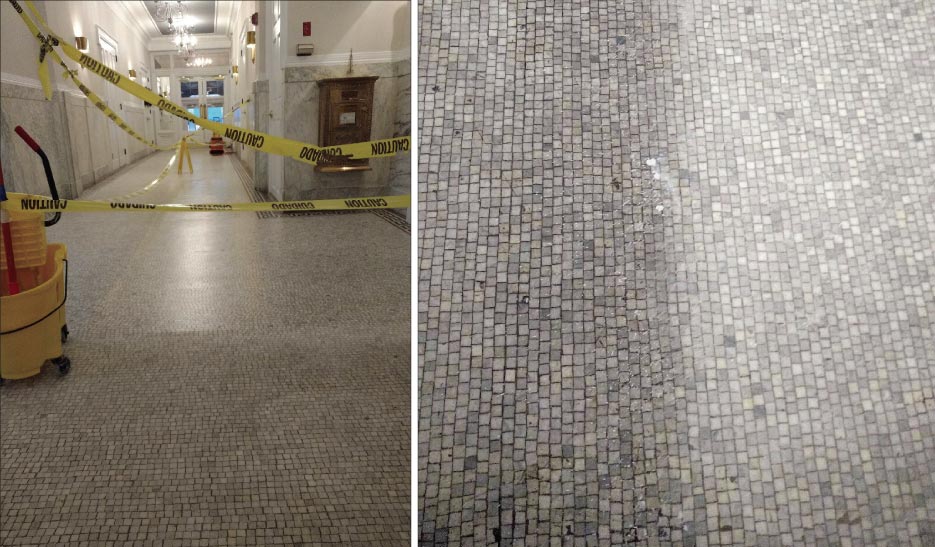 |
|
The difference after honing, re-grouting, cleaning and restoration is dramatic, but still subtle. The floor still has the look of a very old stone installation – their ultimate goal. |
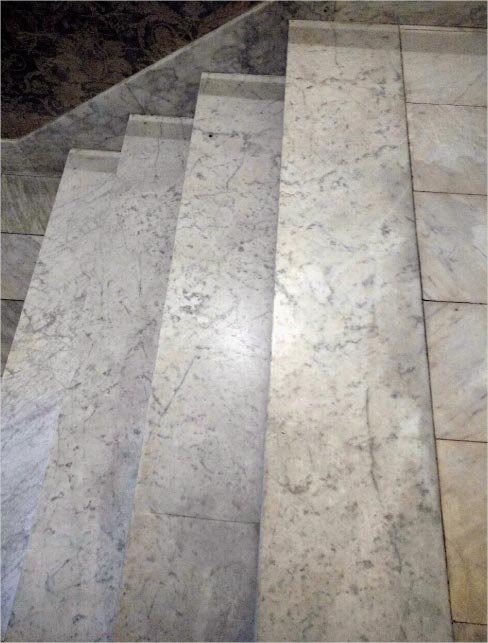 |
|
Entrance steps after restoration. The entrance steps of Carrara marble comprise 95 square feet of material and have seen over a century of traffic. “They took almost as long and as much manpower as the tile floor. A lot of that (had to be) done by hand,” says Sirianni. |
The company completes more than 30 projects per month. A Braxton-Bragg customer since the business started, Marble Restoration Co. relies on products like the Dia-Glo granite polishing kit, Stone Shield sealers, K-Bond Elite adhesives, as well as various Makita hand grinders for honing and grinding repairs.
Sirianni describes the company as being on a huge growth curve. “We have been profitable every month in our existence,” he said.
The next business goal for the company is another 40 percent increase in sales and hiring three to four more technicians.
The company’s senior technicians have a minimum of six years, to 20 years of experience in the field. The rest of the crew has been trained after becoming employed with the company.
Sirianni himself only entered the stone industry about eight years ago. He’s an entrepreneur who has owned packaging, hotel, and restaurant businesses. “I saw this as an incredible business opportunity, and it’s paid off magnificently,” he said.
Though the company is new, Sirianni takes pride that it has established a reputation for its expertise in dealing with historical buildings. “We’re becoming known as the go-to guys for that. What better place to do something like that than Philadelphia? It’s so rich in history.”
The market in the area is growing. “When we look at the demographics it points to the fact that we have barely scratched the surface of the market,” Sirianni said.
The company is focused on customer satisfaction. “It is the 100-percent driving force behind all we do,” he said.
It is also dependent on its employees to ensure that satisfaction. “They are the only reason we are successful,” Sirianni said.
The company relies on word-of-mouth for marketing. It also uses mailings and Internet advertising.
Service and quality sets The Marble Restoration Co. apart from its competitors. “Our team is indoctrinated with our success being totally dependent on how we treat our customers,” Sirianni said.
The focus leads to a commitment to developing its employees. “We invest a lot in our people,” he said. “We do not worry so much about their experience and technical skills at first. We spend a lot of time interviewing potential candidates and need to be convinced of several things: they are truly interested in learning skilled trade; they are turned on by creating a successful end result; they will fit into our corporate culture.
“By that, I mean that they want to be part of a team that cares about the business, the customers and each other. It is not about self and just getting a paycheck. They need to understand the future growth plans and want to be a part of that excitement. They also know that they will share in the success of the company, as many have done so already.”
It takes time to develop the employees to meet company standards. “We invest in training all of our people,” Sirianni said. “So a new hire probably cannot produce for us for a year. We put them through a rigorous apprenticeship, but make sure we pay them above average so they can survive during their training time.”
The approach has paid off. “I believe we are already the largest stone restoration company in the Delaware Valley, with 11 technicians,” Sirianni said. “But, interestingly enough, being the largest has never been our goal. It has always been about being the best and the most honest. Our guys know, if they make a mistake they will not be punished for it, as long as they do the right thing by the customer. Having all the great reviews and testimonials that we get creates the growth naturally. The team knows that if we always do the right thing, at a fair price, the business will always grow.”